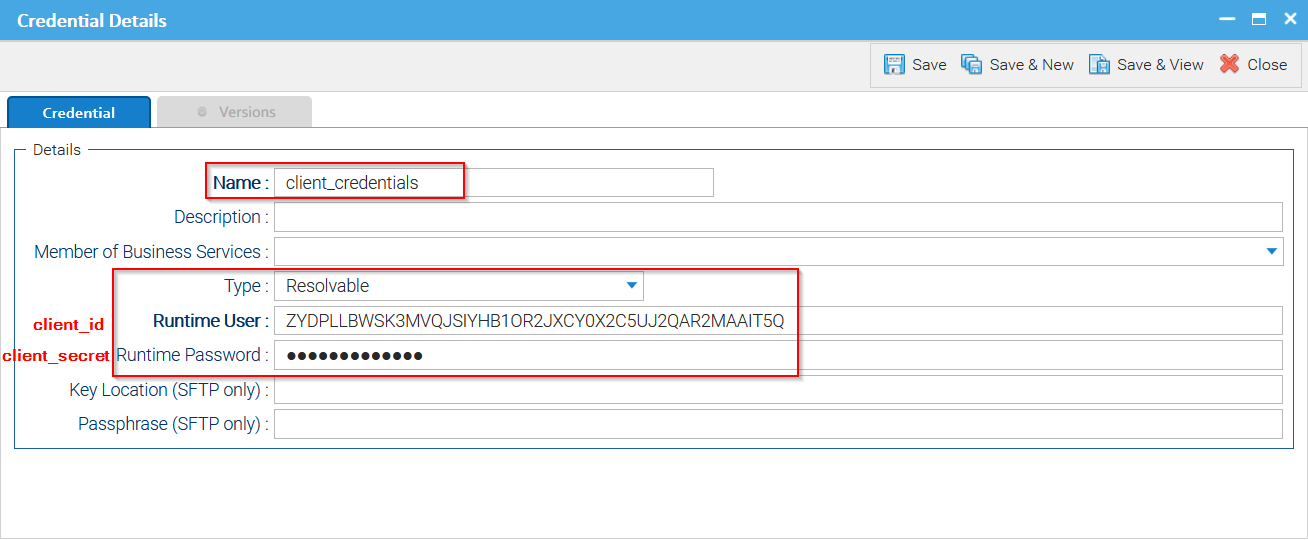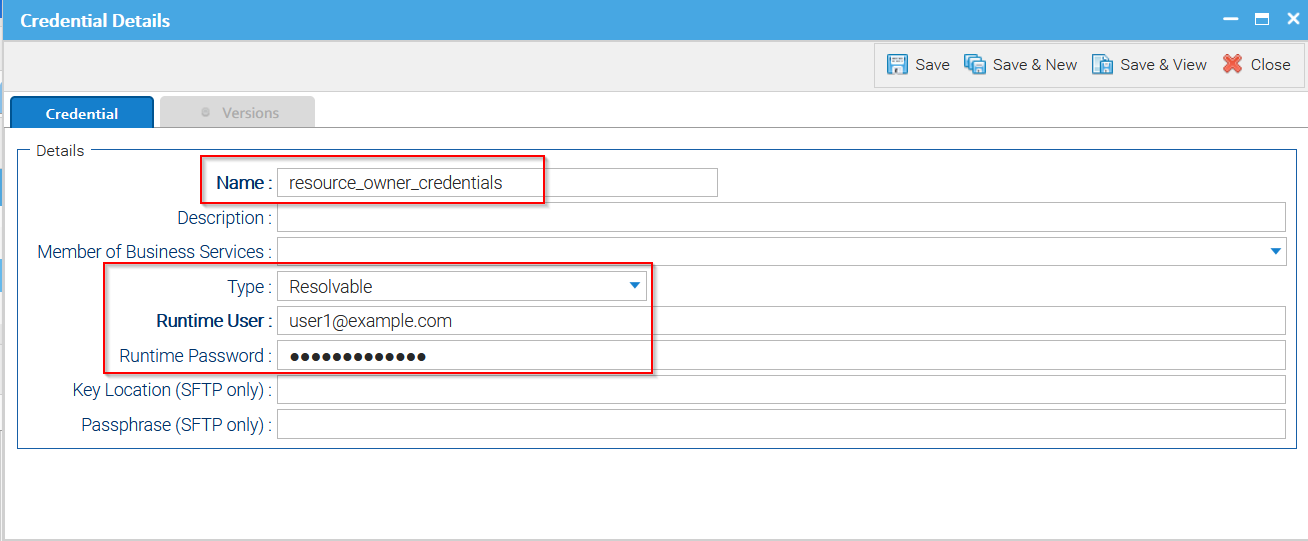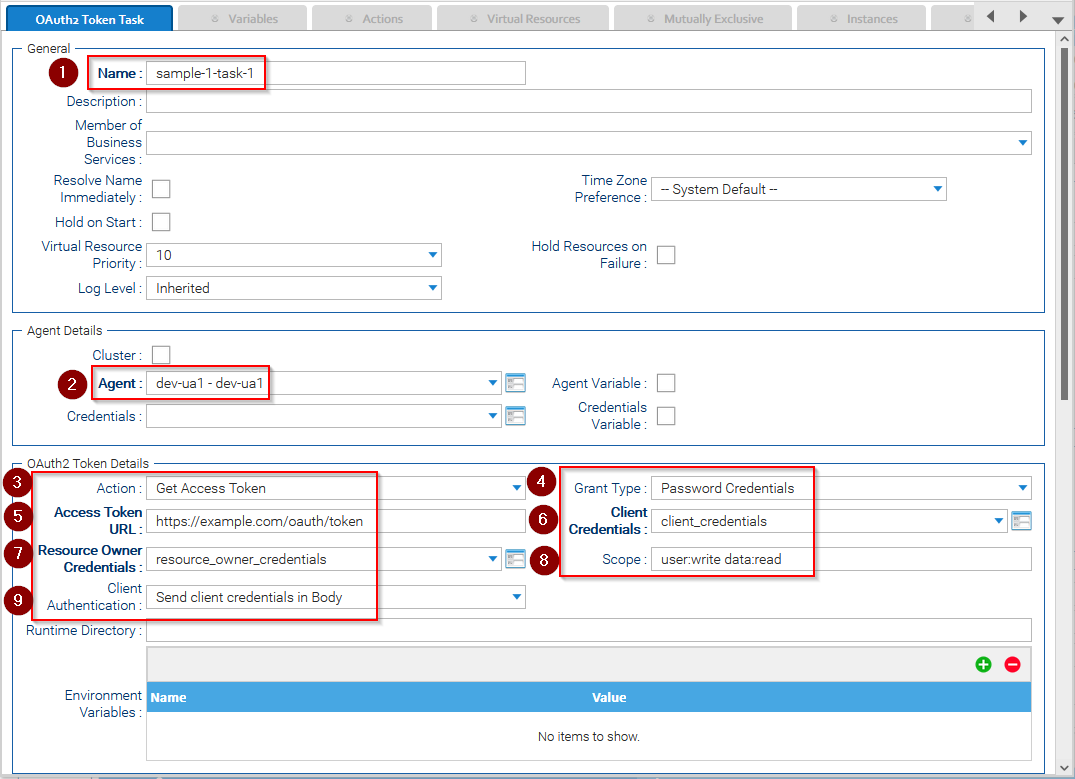Oauth2: Get Token
Disclaimer
Your use of this download is governed by Stonebranch’s Terms of Use, which are available at https://www.stonebranch.com/integration-hub/Terms-and-Privacy/Terms-of-Use/
Overview
The Oauth 2.0 authorization framework enables a third-party application to obtain limited access to an HTTP service, either:
- On behalf of a resource owner by orchestrating an approval interaction between the resource owner and the HTTP service,
- By allowing the third-party application to obtain access on its own behalf.
With Universal Automation Center, you can obtain Oauth2 access tokens that can be used to authorize UAC tasks.
Key Features
This Universal Extension provides the following main features:
Support to obtain Oauth2 Access token for "Resource Owner Password Credentials" (aka "Password Credentials") or "Client Credentials" Grant Types . More information about the supported Grant Types can be found here: Resource Owner Password Credentials Grant , Client Credentials Grant.
Support for authorization scopes.
Support to use the Client Credentials in the request Body or as Basic Authentication Header.
Software Requirements
This integration requires a Universal Agent and a Python runtime to execute the Universal Task.
Software Requirements for Universal Template and Universal Task
Requires Python 3.7.0 or higher. Tested with the Universal Agent bundled Python distribution.
Software Requirements for Universal Agent
Both Windows and Linux agents are supported:
Universal Agent for Windows x64 Version 7.0.0.0 and later with python options installed.
Universal Agent for Linux Version 7.0.0.0 and later with python options installed.
Software Requirements for Universal Controller
Universal Controller Version 7.0.0.0 and later.
Network and Connectivity Requirements
Universal Agent needs to have network access to Access Token URL
Import Universal Template
To use the Universal Template, you first must perform the following steps:
- This Universal Task requires the Resolvable Credentials feature. Check that the Resolvable Credentials Permitted system property has been set to true.
- Download the provided ZIP file.
- In the Universal Controller UI, select Configuration > Universal Templates to display the current list of Universal Templates.
- Click Import Template.
Select the template ZIP file and Import.
When the template has been imported successfully, the Universal Template will appear on the list, refresh your Navigation Tree to see these tasks in the Automation Center Menu.
Configure Universal Task
For the new Universal Task type, create a new task, and enter the task-specific details that were created in the Universal Template
Input Fields
The input fields for this Universal Extension are described below.
Field | Input type | Default value | Type | Description |
|---|---|---|---|---|
Action | Required | Get Access Token | Choice | "Get Access Token": The action that gets an access token from the Server. |
Grant Type | Required | Password Credentials | Choice | The OAuth 2.0 Grant Type used to get the token. Supported Grant Types are:
|
Access Token URL | Required | - | Text | The endpoint for authentication server. It is used to exchange the Client Credentials (and the Resource Owner Credentials in the case of "Password Credentials" Grant Type) for an access token. |
Client Credentials | Required | - | Credentials | Client credentials are comprised of:
|
Resource Owner Credentials | Required | - | Credentials | Required only for Grant Type "Password Credentials". The Resource Owner Credentials are comprised of:
|
Scope | Optional | - | Text | A space-separated list of scopes of the request. |
Client Authentication | Required | Sent in Body | Choice | Controls whether the client credentials are sent in the request body or as a basic authentication header:
|
Task Examples
Follow the steps below to create a OAuth2 Authentication Token Task using "Password Credentials" Grant Type.
The same process can be followed for "Client Credentials" Grant Type (in this case Resource Owner Credentials are not required).
Give the task a name (for example, sample-1-task-1).
Select an active agent of version 7.0.0.0 or higher for the task to run on.
Select the action.
Select the Grant Type.
Fill the Access Token URL field.
Set your Client Credentials.
Example of Client Credentials:- Set your Resource Owner Credentials.
Example of Resource Owner Credentials: Fill the scope.
Select the client authentication method.
Example of Get Access Token Action:
Output Fields
The output fields for this Universal Extension are described below.
Field | Type | Description |
|---|---|---|
Access Token | Large Text | The access token in the case of successful execution. Although it is an output field, it is hidden by default. UAC tasks that require the generated access token for authorization purposes can reference the variable ops_oauth_token_access_token of the respective Oauth Token task instance |
Exit Codes
The exit codes for this Universal Extension are described below.
Exit Code | Description |
|---|---|
0 | access token is retrieved successfully |
1 | there was an error during execution of Universal Extension |
Document References
This document references the following documents:
Name | Description |
|---|---|
User documentation for creating Universal Templates in the Universal Controller user interface. | |
User documentation for creating Universal Tasks in the Universal Controller user interface. | |
User Documentation for Credentials Details Field Description. |
Disclaimer
Your use of this download is governed by Stonebranch’s Terms of Use, which are available at https://www.stonebranch.com/integration-hub/Terms-and-Privacy/Terms-of-Use/
Overview
The Oauth 2.0 authorization framework enables a third-party application to obtain limited access to an HTTP service, either:
- On behalf of a resource owner by orchestrating an approval interaction between the resource owner and the HTTP service,
- By allowing the third-party application to obtain access on its own behalf.
With Universal Automation Center, you can obtain Oauth2 access tokens that can be used to authorize UAC tasks.
Key Features
This Universal Extension provides the following main features:
Support to obtain Oauth2 Access token for "Resource Owner Password Credentials" (aka "Password Credentials") or "Client Credentials" Grant Types . More information about the supported Grant Types can be found here: Resource Owner Password Credentials Grant , Client Credentials Grant.
Support for authorization scopes.
Support to use the Client Credentials in the request Body or as Basic Authentication Header.
Software Requirements
This integration requires a Universal Agent and a Python runtime to execute the Universal Task.
Software Requirements for Universal Template and Universal Task
Requires Python 3.7.0 or higher. Tested with the Universal Agent bundled Python distribution.
Software Requirements for Universal Agent
Both Windows and Linux agents are supported:
Universal Agent for Windows x64 Version 7.0.0.0 and later with python options installed.
Universal Agent for Linux Version 7.0.0.0 and later with python options installed.
Software Requirements for Universal Controller
Universal Controller Version 7.0.0.0 and later.
Network and Connectivity Requirements
Universal Agent needs to have network access to Access Token URL
Import Universal Template
To use the Universal Template, you first must perform the following steps:
- This Universal Task requires the Resolvable Credentials feature. Check that the Resolvable Credentials Permitted system property has been set to true.
- Download the provided ZIP file.
- In the Universal Controller UI, select Configuration > Universal Templates to display the current list of Universal Templates.
- Click Import Template.
Select the template ZIP file and Import.
When the template has been imported successfully, the Universal Template will appear on the list, refresh your Navigation Tree to see these tasks in the Automation Center Menu.
Configure Universal Task
For the new Universal Task type, create a new task, and enter the task-specific details that were created in the Universal Template
Input Fields
The input fields for this Universal Extension are described below.
Field | Input type | Default value | Type | Description |
|---|---|---|---|---|
Action | Required | Get Access Token | Choice | "Get Access Token": The action that gets an access token from the Server. |
Grant Type | Required | Password Credentials | Choice | The OAuth 2.0 Grant Type used to get the token. Supported Grant Types are:
|
Access Token URL | Required | - | Text | The endpoint for authentication server. It is used to exchange the Client Credentials (and the Resource Owner Credentials in the case of "Password Credentials" Grant Type) for an access token. |
Client Credentials | Required | - | Credentials | Client credentials are comprised of:
|
Resource Owner Credentials | Required | - | Credentials | Required only for Grant Type "Password Credentials". The Resource Owner Credentials are comprised of:
|
Scope | Optional | - | Text | A space-separated list of scopes of the request. |
Client Authentication | Required | Sent in Body | Choice | Controls whether the client credentials are sent in the request body or as a basic authentication header:
|
Task Examples
Follow the steps below to create a OAuth2 Authentication Token Task using "Password Credentials" Grant Type.
The same process can be followed for "Client Credentials" Grant Type (in this case Resource Owner Credentials are not required).
Give the task a name (for example, sample-1-task-1).
Select an active agent of version 7.0.0.0 or higher for the task to run on.
Select the action.
Select the Grant Type.
Fill the Access Token URL field.
Set your Client Credentials.
Example of Client Credentials:- Set your Resource Owner Credentials.
Example of Resource Owner Credentials: Fill the scope.
Select the client authentication method.
Example of Get Access Token Action:
Output Fields
The output fields for this Universal Extension are described below.
Field | Type | Description |
|---|---|---|
Access Token | Large Text | The access token in the case of successful execution. Although it is an output field, it is hidden by default. UAC tasks that require the generated access token for authorization purposes can reference the variable ops_oauth_token_access_token of the respective Oauth Token task instance |
Exit Codes
The exit codes for this Universal Extension are described below.
Exit Code | Description |
|---|---|
0 | access token is retrieved successfully |
1 | there was an error during execution of Universal Extension |
Document References
This document references the following documents:
Name | Description |
|---|---|
User documentation for creating Universal Templates in the Universal Controller user interface. | |
User documentation for creating Universal Tasks in the Universal Controller user interface. | |
User Documentation for Credentials Details Field Description. |


